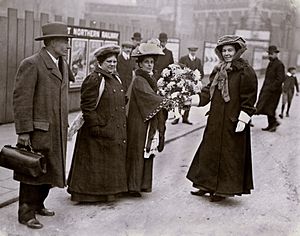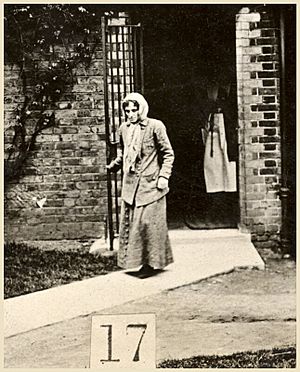Sarah Jane Baines facts for kids
Sarah Jane Baines (born November 30, 1866 – died February 20, 1951) was a brave woman from Britain and Australia. She fought for women's rights and helped make society better. People often called her Jennie Baines. She was a suffragette, meaning she worked hard for women to get the right to vote. Jennie was also one of the first to go on a hunger strike to protest for her cause. She was even the first suffragette to have her case heard by a jury.
Contents
Early Life and Work
Sarah Jane Baines was born in Birmingham, England, in 1866. Her parents were Sarah Ann and James Edward Hunt. Her father made guns for a living.
When she was just eleven years old, Sarah started working at a factory that made weapons.
At age fourteen, Sarah and her parents joined the Salvation Army. When she was twenty, she became a leader in the Salvation Army. She helped people in Bolton and even supported women who had been arrested.

On September 26, 1888, she married George Baines in Bolton. George made boots and shoes. They had five children together, but only three lived past childhood.
Even with a family and working as a sewing machinist, Jennie stayed committed to her cause. Her youngest child was six when she was sent to prison for the third time. Annie Kenney, another suffragette, called her "one of the most kind-hearted women." Jennie also joined the Independent Labour Party. She worked on committees to help feed school children and support unemployed people.
Fighting for Women's Vote
In October 1905, Jennie Baines learned about the arrest of suffragettes Annie Kenney and Christabel Pankhurst. This made her want to join the Women's Social and Political Union (WSPU). At first, she volunteered, but in February 1908, she became a paid organizer. She earned £2 a week. Her job was to arrange outdoor meetings, interrupt other meetings, and start new WSPU groups in the North of England and the Midlands.
Later that year, in November 1908, Jennie was put on trial in Leeds. She was accused of holding an unlawful meeting. She was the first WSPU member to be tried by a jury. She refused to promise to stop her protests. Because of this, she was sent to Armley Goal prison in Leeds for six weeks. She said she did "not recognise the laws of this Court administered by men."
Jennie was one of the first to support strong protest methods. She was sent to prison about fifteen times for her part in protests. In July 1909, she was jailed with twelve others. This group included Mary Leigh, Lucy Burns, Alice Paul, Emily Davison, and Mabel Capper. They were arrested for trying to stop a public meeting held by David Lloyd George in Limehouse.
On the way to Holloway prison, the women protested loudly. They demanded to be treated as "political" prisoners. They wanted to wear their own clothes and be in a special part of the prison. This was not allowed. The women then broke 150 windowpanes at the prison. They also refused to give their names. Prison officers had to use "force necessary" to make the women wear prison clothes.
In Liverpool in 1910, Jennie was giving speeches with Ada Flatman and Patricia Woodlock. Constance Lytton, disguised as a seamstress named 'Jane Wharton', joined them. She asked the people of Liverpool to help stop the "force-feeding" of prisoners. A crowd followed them to the prison Governor's house, with police chasing them.
In July 1912, Jennie, using the name 'Lizzie Baker', tried to burn down the Theatre Royal in Dublin. She was with Gladys Evans, Mary Leigh, and Mabel Capper. This happened the night before Prime Minister H.H. Asquith was scheduled to visit. For this, Jennie was sentenced to seven months of hard labor in Central Bridewell prison, Dublin. She joined other suffragette prisoners on a hunger strike. She was released after five days.
The next year, on July 8, 1913, Jennie, her husband George, and son Wilfred were accused of trying to bomb railway carriages. This happened near their home in Manchester. Police found a bomb, a loaded gun, masks, and tools at their home. Her husband and son were charged but not imprisoned. Jennie was arrested again under the 'Cat and Mouse act'. She was sent back to Holloway Prison. She went on hunger strike again, refusing food and water. She was released in a "very serious condition."
Jennie had a condition called chorea, also known as St Vitus’ Dance. This caused spasms when she was stressed. This made it very hard to force-feed her. Jennie was given a Hunger Strike Medal for her bravery.
In May 1913, Jennie was arrested again for causing a disturbance at a meeting in Hyde Park. She was sentenced to one month in prison. WSPU leaders decided her health could not handle another prison stay. So, Jennie and her family were secretly taken to Wales. They used the name 'Evans' and sailed to Australia on a ship called The Ballarat. This happened before their family trial was due in November 1913. The trial went ahead, and George and Wilfred Baines were found not guilty. The WSPU saw this move to Australia as a reward for all Jennie had done. Australia had already given women the right to vote in 1902.
Life in Australia
After being secretly moved out of England, Jennie Baines arrived in Melbourne, Australia, in December 1913. She was forty-seven years old.
Adela Pankhurst, another suffragette, would arrive in Australia in 1914.
Jennie's family settled in Fitzroy, a suburb of Melbourne. They joined the Victorian Socialist Party and the Labour Party. Jennie quickly started working with the Women's Political Association in January 1914. She also helped start the Women's Peace Army. With Adele Pankhurst, Jennie campaigned against men being forced to join the army during World War I (1916-1917). They also protested against the rising cost of living. Both women were sentenced to nine months in prison, but they were freed after an appeal.
Jennie was jailed again in March 1919. This time, it was for flying a forbidden red flag. She became the first prisoner in Australia to go on a hunger strike. A special government meeting was held. She was released after four days of not eating, based on the advice of the Attorney-General.
In 1920, Jennie helped create the Communist Party in Victoria. Five years later, she was removed from the party. She then rejoined the Labour Party.
In 1926, her family moved to Port Melbourne. From 1928 to 1948, Jennie was a special judge for the Children's Court there.
Death and Lasting Impact
After the Second World War, Jennie's activities were limited because her eyesight was failing. However, Sarah Jane Baines continued her "fiery eloquence" in public speaking. She only stopped a few months before she died from cancer on February 20, 1951, in Port Melbourne.
Jennie was survived by her husband and her three children. Her impact can be understood through her own words:
'To fight for that which is better and nobler in this world is to live in the highest sense, but to submit and tolerate the evils which exist is to merely vegetate in the sewers of iniquity'. Jennie Baines quoted in The Socialist, 11 April 1919.
See also
 In Spanish: Sarah Baines para niños
In Spanish: Sarah Baines para niños



